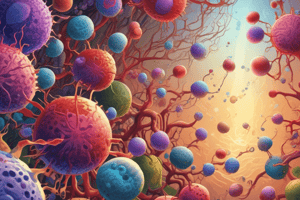Podcast
Questions and Answers
What are NK cells considered?
What are NK cells considered?
Cytotoxic innate lymphocytes
Where are NK cells derived from?
Where are NK cells derived from?
The same lymphoid precursor as B and T cells
What are the three classes of lymphocytes?
What are the three classes of lymphocytes?
B cell, T cell, NK cell
What is a lymphocyte typically defined as?
What is a lymphocyte typically defined as?
NK cells are most closely related to __________, and have similar effector functions.
NK cells are most closely related to __________, and have similar effector functions.
Like CD8 T cells, NK cells are specialized to identify and eliminate virally infected and ________________ cells.
Like CD8 T cells, NK cells are specialized to identify and eliminate virally infected and ________________ cells.
NK cells can also eliminate ______________ cells.
NK cells can also eliminate ______________ cells.
Unlike CD8 T cells, NK cells do not have an antigen-specific receptor and generally do not develop memory.
Unlike CD8 T cells, NK cells do not have an antigen-specific receptor and generally do not develop memory.
Which part of the immune system are NK cells classified as and why?
Which part of the immune system are NK cells classified as and why?
What do perforins do, and what do they allow granzymes to do?
What do perforins do, and what do they allow granzymes to do?
Once in the cell, what function do granzymes have?
Once in the cell, what function do granzymes have?
Unlike CD8 T cells, NK cells lack A_ specificity.
Unlike CD8 T cells, NK cells lack A_ specificity.
Induces cells to go into apoptosis in around 60 min.
Induces cells to go into apoptosis in around 60 min.
In order to distinguish healthy cells from malignant or infected cells, NK cells express a variety of __________________ on their cell surface.
In order to distinguish healthy cells from malignant or infected cells, NK cells express a variety of __________________ on their cell surface.
There are ______ receptor families expressed on NK cells classified on their structure. Name them.
There are ______ receptor families expressed on NK cells classified on their structure. Name them.
In the cytoplasmic region of the receptor in an NK cell, all receptors are chosen as either activating or inhibitory by the A or B_ in the cytoplasmic region of the receptor.
In the cytoplasmic region of the receptor in an NK cell, all receptors are chosen as either activating or inhibitory by the A or B_ in the cytoplasmic region of the receptor.
Phosphorylation of ________ can initiate signaling and phosphorylation of _____________ can dampen signaling.
Phosphorylation of ________ can initiate signaling and phosphorylation of _____________ can dampen signaling.
This picture shows ZAP-70 (kinase) joining to an _____________ receptor's ITAM.
This picture shows ZAP-70 (kinase) joining to an _____________ receptor's ITAM.
____________ binds to ITIM and signals the cell to dampen (make less strong or intense.). What kind of receptor?
____________ binds to ITIM and signals the cell to dampen (make less strong or intense.). What kind of receptor?
The ligands for activating receptors are often structurally related to MHC class I called __________________, and are only expressed by _____________ cells.
The ligands for activating receptors are often structurally related to MHC class I called __________________, and are only expressed by _____________ cells.
What type of receptor is A.CD94:NKG2A?
What type of receptor is A.CD94:NKG2A?
Flashcards are hidden until you start studying
Study Notes
Natural Killer Cells Overview
- NK cells are cytotoxic innate lymphocytes that play a crucial role in the immune system.
- Derived from the same lymphoid precursor as B and T cells, NK cells contribute to overall immune function.
Lymphocyte Classification
- Three main classes of lymphocytes: B cells, T cells, and NK cells.
- Lymphocytes are typically characterized by their large round nucleus and circular shape.
Relation to Other Immune Cells
- NK cells exhibit similarities to CD8 T cells in function, especially in targeting infected or cancerous cells.
- Both NK cells and CD8 T cells identify and eliminate virally infected or cancerous cells.
Functional Characteristics
- Unlike CD8 T cells, NK cells lack antigen-specific receptors and do not develop memory.
- NK cells are part of the innate immune system, responding quickly to infections without antigen specificity.
Mechanism of Action
- NK cells, similar to cytotoxic T cells, release perforins and granzymes upon recognizing infected or cancerous cells.
- Perforins form pores in target cell membranes, allowing granzymes to enter and trigger apoptosis through activation of caspases.
Activation and Inhibition
- NK cells can be activated in large quantities during immune responses, inducing apoptosis within approximately 60 minutes.
- To differentiate between healthy and abnormal cells, NK cells express a variety of activating and inhibitory receptors.
Receptor Families
- NK cells have several receptor families, including: KIR (Killer Immunoglobulin-like Receptors), KLR (Killer Lectin-like Receptors), and NCR (Natural Cytotoxicity Receptors).
- Various receptors on NK cells can either activate or inhibit their function.
Specific Receptors
- Specific activating receptors include KIR-2DS, KIR-3DS, and KLR (NKG2C).
- Inhibitory receptors include KIR-2DL, KIR-3DL, and KLR (NKG2A).
Signaling Mechanisms
- All NK cell receptors utilize immunoreceptor tyrosine-based motifs (ITAMs) for activation or immunoreceptor tyrosine-based inhibition motifs (ITIMs) for inhibition in their cytoplasmic regions.
- Activation signaling is initiated through phosphorylated ITAMs, while ITIMs, when phosphorylated, recruit phosphatases to dampen signaling.
Development of NK Cells
- NK cells exhibit variegated expression, allowing them to show different combinations of receptor expressions as they mature, contributing to a diverse NK cell population.
Ligands and Activation
- An inhibitory receptor, CD94:NKG2A, recognizes HLA-E complexes, which are derived from MHC I.
- Activating receptors often bind to ligands such as MIC proteins, expressed on stressed cells, aiding in the activation of NK cells in immune responses.
Studying That Suits You
Use AI to generate personalized quizzes and flashcards to suit your learning preferences.




